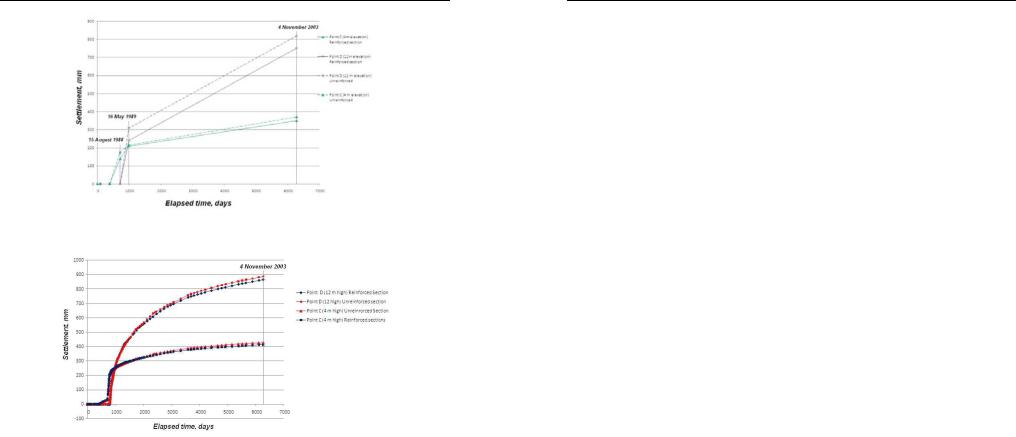
Сборник трудов конференции СПбГАСУ 2012
.pdf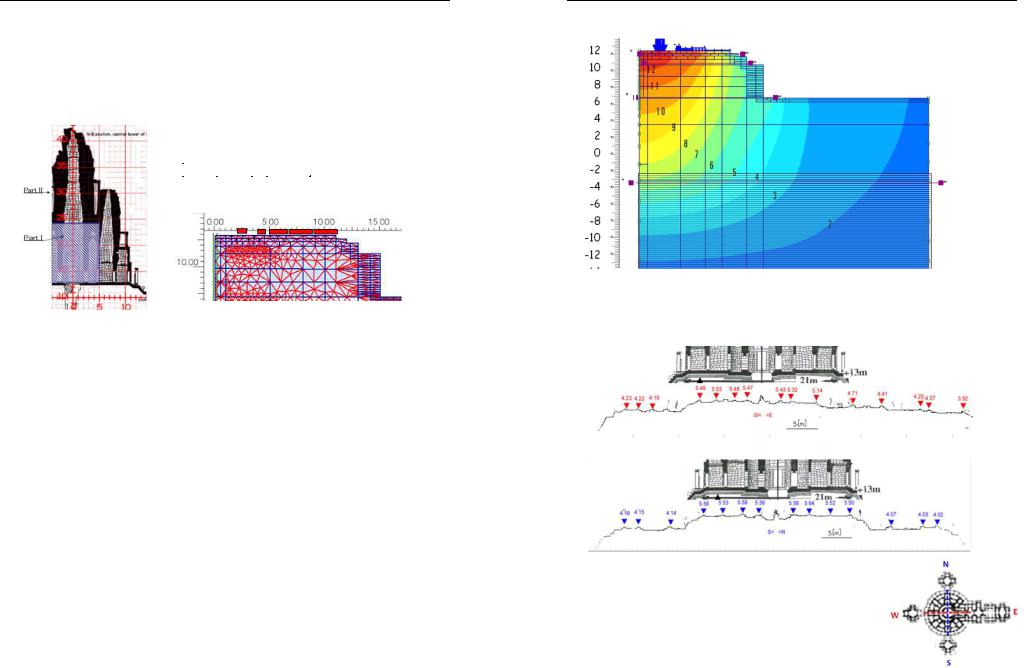
Численные методы расчетов в практической геотехнике
4. Simulation of the Construction of the Central Tower
The construction of the central tower can be divided into three steps: (1) earth fill construction, (2)lower structure of the central tower, and (3) the subtowers and the upper structure of the central tower. Steps (2) and (3) correspond to Part I and Part II in Fig. 7.
Load(kPa)
|
(2-3)m |
|
(4.5-5.0)m |
|
(5-6.5)m |
(6.5-8)m |
(8-11)m |
1st step |
290 |
|
360 |
|
|
|
|
|
|
|
|
|
|
|
|
2nd step |
1400 |
|
560 |
280 |
340 |
70 |
|
Fig. 7. Two steps for Bayon construction
5.Analysis Result
Fig. 6 shows equi-settlement contour lines of the soil foundation after the loads of the two steps have been applied. The result of this calculation was a settlement of around 12cm at the center of the main tower, 10cmat the edges ofthe main tower, and around 7 to 8 cm around the periphery of the subtowers.
Fig. 9 shows measured heights at the north-south crossroad of the main tower. It is clear from this figure that in both of the north-south and east-west sections, the heightofthecentralareaisnotnecessarilylowerthanitsperiphery.Wedidnotscrutinize this point in detail, since it is unclear how the height of the foundation was established in the first place, at the time of construction of the central tower.
6. Simulation of the Excavation inside the Main Chamber of the Central Tower
In 1933, a roughly 14m-deep shaft was dug in the center of the main chamber and backfilled, but the backfill was not compacted. To examine this condition, we excavateda2m-diametershaftinthecentralareafromthegroundsurfaceandobserved changes in stress.
Yoshinori Iwasaki
Fig. 8. Equi-settlement contour lines in soil foundation after completion of Bayon Tower
Fig. 9 Height of the base mound for the
Central Tower S-N and W-E sections
278 |
279 |
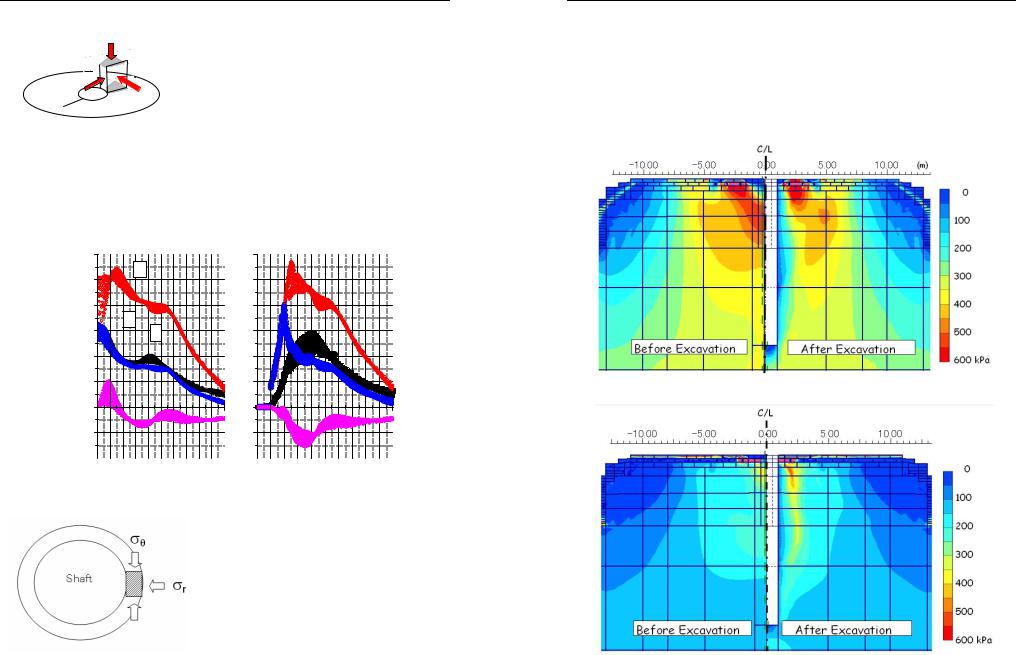
Численные методы расчетов в практической геотехнике
σFig. 11 shows changes in stress around the v shaftbeforeand aftershaftexcavationatlevel from GL+10m to +11m directly beneath the foundation.
|
|
σθ |
Thehorizontalaxisrepresentsthedistancefromthe |
|
|
||
σ |
|
center of the tower, and the vertical, radial, and |
|
|
tangential stress values obtained from analysis are |
||
|
r |
plotted in the graphs. |
|
|
|
|
One of the characteristics of stress |
Fig. 10. Stress System |
redistribution observed after shaft excavation was |
||
|
|
|
thatthestressperpendiculartotheshaftsexcavation |
surface, or radial stress, became zero at the boundary of the shaft. This is because the airpressurewasappliedtotheexcavatedsurfacesothatradialstresspracticallybecame zero at a radius of 1m.
|
(kPa) |
Stress from GL+10-11m |
|
600 |
600 |
||
|
|||
|
|
Sv |
|
500 |
|
500 |
|
400 |
|
|
|
|
|
|
|
|
|
|
|
400 |
|
|
|
|
|
|
|
|
|
|
|
|
-11m) |
300 |
|
|
Sr |
|
|
|
|
|
|
|
|
300 |
|
|
|
|
|
|
|
|
|
|
|
|
|
|
|
|
Sθ |
|
|
|
|
|
|
|
|
|
|
|
|
|
|
|
|
|||||
GL+10 |
200 |
|
|
|
|
|
|
|
|
|
|
|
200 |
|
|
|
|
|
|
|
|
|
|
|
|
(from |
100 |
|
|
|
|
|
|
|
|
|
|
|
100 |
|
|
|
|
|
|
|
|
|
|
|
|
Stress |
0 |
0 |
1 |
2 |
3 |
4 |
5 |
6 |
7 |
8 |
9 |
10 |
|
0 |
0 |
1 |
2 |
3 |
4 |
5 |
6 |
7 |
8 |
9 |
10 |
|
|
|
Distance from the Center |
(m) |
|
|
|
Distance from the Center |
(m) |
||||||||||||||||
|
-100 |
|
|
|
|
|
|
|
|
|
|
|
-100 |
|
|
|
|
|
|
|
|
|
|
|
|
-200 |
|
(before excavation) |
-200 |
|
(after excavation) |
|
|
||||
|
|
|
|
Fig. 11. Change of stress by shaft excavation at level GL;10-11m
However, radial stress increased with greater distance from the shaft surface due to cohesion and the internal angle of friction and peakedatr=4m,butdecreasedatdistancesover 4m.
Tangential stress runs perpendicular to radialstress. Itinducesa compressive stressin the shape of a ring around the shaft, maximum
Fig. 12. Stress state around shaft ring stress occurred near r=2m at the height of the ground level.
Yoshinori Iwasaki
The stability issue around the axi-symmetric shaft cavity can be explained in terms of shear failure caused by differential stress between tangential and radial stress inthe ringofground,asshowninFig.12.Ifshear strengthissufficientlylarge,tangential stressbecomeslargest at the shaftsurfaceand then decreasesas the radius increases. If shear strength is small, a failure occurs, and the stress also decreases in strength.
AsshowninFig.13,tangentialstresswaslargerthanshearstrengthbetweenr=1m andr=2m,sostressredistributionoccurredanddecreasedshearstress.Thismeansthatthe stress ringoccurred near r = 2 m, and the area inside r = 2mwasa stress-free zone.
Fig. 13. Change of vertical stress(σv) in the foundation mound by vertical shaft
Fig. 14. Change of tangential stress(σθ) in the foundation mound by vertical shaft
280 |
281 |
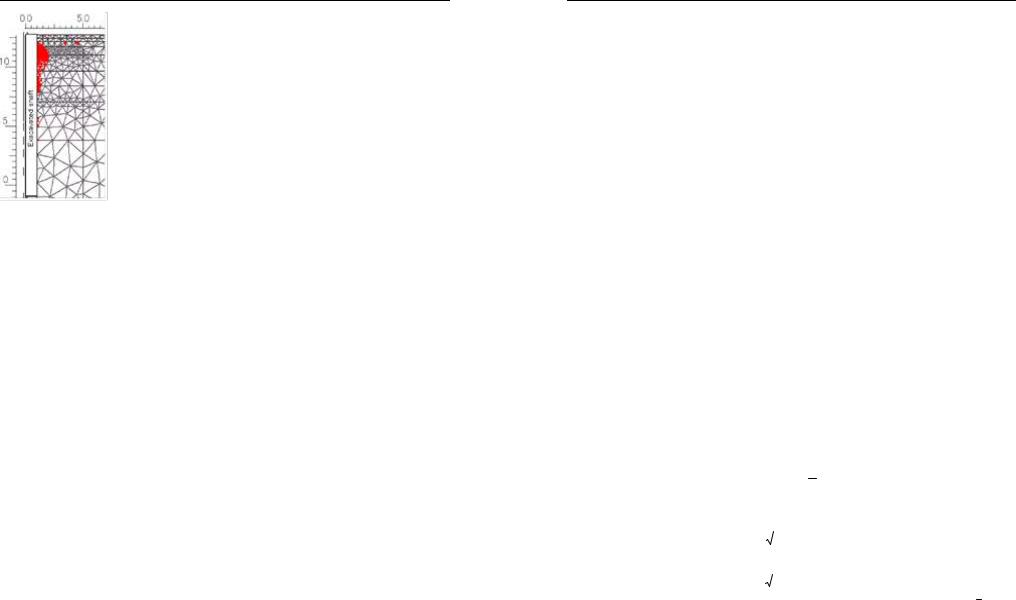
Численные методы расчетов в практической геотехнике
Figs. 13 and 14 showstress distribution in the platform ground before and after shaft excavation. Fig. 13 shows changes in vertical stress and Fig. 14 shows changes in tangentialstress.Vertical stresswaszero atthegroundsurface in the center of the platform before shaft excavation, and the formationofaconicalstresswedgeprovidedstability,butafter shaft excavation, the center of the wedge disappeared, and a concentration of vertical stress occurred directly beneath the elliptical foundation inside the main chamber.
The sandy soil of Angkor is strong when it is dry, but becomes weak in wet condition. Because strength decreases in times of flood, this condition becomes dangerous from a broad perspective.
Fig. 15 shows the estimated plastic range of the ground around the shaft. It is subject to change according to the strength conditions (Table-1)that areinitiallyset. In other words, if strengthincreases,
the plastic range shrinks, and if strength decreases, the plastic range expands.
7. Conclusion
It is surprising that the chamber existed on hollow ground without collapsing for some 75 years since the 1933 excavation, although the sitting Buddha statue was buried even way before that. Rainfall from the top of the tower is not completely blocked, but it seems that when a plastic range was formed around the cavity, a large confining stress created by the concentration of vertical pressure near a distance of 2.5 m from the center prevented the expansion of the plastic region and helped maintain stability. However, if rainwater seeps into the earth fill around the cavity, the chamberwouldcollapse.Toprovidepermanentstability,suchmeasuresasre-excavation of the shaft to compact the loose fill of the pit as well as applying a lining.
T. Tanaka (The JapanAssociation of Rural Solutions for Environmental Conservation and Resource Recycling (JARUS), Tokyo, Japan)
M. Ariyosh, Y. Mohri (National Institute for Rural Engineering, Tsukuba, Japan)
DISPLACEMENT, STRESSAND STRAIN OFFLEXIBLEBURIED PIPE TAKINGINTOACCOUNTTHE CONSTRUCTION PROCESS
There are few suitable studies concerning the deformation analysis of a large scale flexible pipe that is taking into account the construction process with a complex earth pressure condition. In this study we attempted to clarify the deformation, stress
282
T. Tanaka, M. Ariyosh, Y. Mohri
andstrainofpipebythefiniteelementanalysiswithimplicit-explicitdynamicrelaxation method. By comparing theresults of real scale field experiment with those of the finite elementanalysis,weestimatedthepossibilityofthefiniteelementanalysisforprediction of deormation, stress and strain of large scale buried pipe. The displacement and stress by the finite element analysis agreed well to those of field experiment.
1.INTRODUCTION
This paper presents deformation, stress and strain of a large scale flexible pipe that is taking into account the construction process: excavation and back-filling. It seemsimportanttodevelopanumericalmethodforanalyzingsuchcomplexinteractive action of soils and flexible structure. The problem was attempted to solve by elastoplastic finite element analysis with implicit-explicit dynamic relaxation method. Field experiments were carried out by measuring the deflections and strains of steel pipe, then mechanical properties of soils were determined by triaxial tests. Comparing the resultsoftheanalysisandtheexperiment,thereliabilityofthedevelopedelasto-plastic analysis with construction process was evaluated.
2.MATERAILMODEL
A material model for a real granular material was used with the features of nonlinearpre-peak,pressure-sensitivityofthedeformationand strengthcharacteristics of sand, non-associated flow characteristics, post-peak strain softening, and strainlocalization into a shearband with aspecific width (Tatsuokaetal., 1991; Siddiqueeet al., 1999). The material model is briefly described in this section.
The yield function ( f ) and the plastic potential function (Ф) are given by;
|
|
|
|
σ |
|
|||||
f = αI1 + |
|
|
|
− K = 0 |
(1) |
|||||
|
g(θL ) |
|||||||||
Φ =α′I1 + |
σ |
= 0 |
(2) |
|||||||
where |
|
|
|
|
|
|
|
|
|
|
α = |
|
|
|
2sinφ |
(3) |
|||||
|
|
|
|
|
|
|
|
|
|
|
|
|
3(3− sinφ ) |
||||||||
|
|
|
||||||||
α′ = |
|
|
|
2sinψ |
(4) |
|||||
|
|
|
|
|
|
|
|
|
||
|
3(3−sinψ ) |
|||||||||
|
|
|
||||||||
where I1 is the first invariant (positive in tension) of deviatoric stresses and σ is the
second invariant of deviatoric stress. With the Mohr-Coulomb model, g(θL ) takes the following form;
283
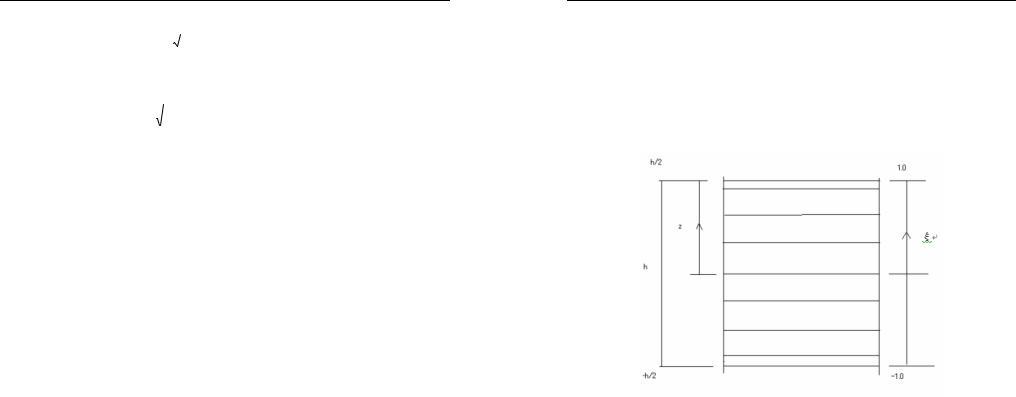
Численные методы расчетов в практической геотехнике
g(θL )= |
|
|
3− sinφ |
(5) |
|
|
|
|
|||
2 |
3cosθL − 2sinθL sinφ |
||||
|
|
||||
φ is the mobilized friction angle andθL is the Lode angle. The frictional hardeningsoftening functions expressed as follows were used;
|
|
|
|
|
m |
|
|
|
|
|
|
|
2 |
κε |
f |
|
|
|
|
|
|
||||
|
|
|
|
|
|
|
|
|
|
|
||
α(κ)= |
|
|
|
|
|
|
αp |
|
(κ ≤ ε f ):hardening-regime |
(6) |
||
κ + ε f |
|
|
||||||||||
|
|
|
|
|
|
|
|
|
||||
|
|
|
|
|
|
|
|
|
|
|
|
|
|
|
|
|
κ −ε |
f |
2 |
|
|
||||
|
|
|
|
|
|
|
|
|
|
|
||
α(κ)= αr +(αp −αr )exp − |
|
|
|
|
|
|
|
|
0 (κ ≥ ε f ): softening-regime |
(7) |
||
|
|
ε |
r |
|
||||||||
|
|
|
|
|
|
|
|
|
|
|
||
|
|
|
|
|
|
|
|
|
|
|
|
|
where m, ε f and εr are the materialconstantsand α p and αr are the valuesof α at the peak and residual states.
The residual friction angle (φr ) and Poissons ratio (ν ) werechosen based on the
data from the test of air-dried dense Toyoura sand. The elastic moduli are estimated using the following equations.
|
(2.17 − e )2 |
p 0.4 |
|
|
|
|||
G = 900 |
|
|
|
|
pa ( pa = 98kPa ) |
(8) |
||
|
|
|||||||
1 + e |
|
|
|
|||||
|
|
pa |
|
|
|
|||
|
K = |
|
|
2(1 +ν ) |
G |
(9) |
||
|
|
3(1− 2ν ) |
||||||
|
|
|
|
|
||||
Thepeakfrictionangle(φP )wasestimatedfromthefollowingempiricalrelations
based on the plane strain compression test on dense Toyoura sand.
The peak friction angle is a function of confining pressure, initial void ratio e and angle δ of the direction of major principal stress σ1 relative to the horizontal
bedding plane. The dilatancy angle (ψ ) was estimated from Rowes stress-dilatancy relation.
The introduction of shear banding in the numerical analysis was achieved by introducing a strain localization parameter s in the following additive decomposition of total strain increment as follows;
dεij = dεije + sdεijp , s = Fb / Fe |
(10) |
where Fb is the area of a single shear band in each element and Fe |
is the area of the |
element |
|
3. FINITE ELEMENTANALYSIS
The finite element used in this study is a pseudo-equilibrium model by one-point integration of a 4-noded Lagrange-type element. The implicit-explicit dynamic
284
T. Tanaka, M. Ariyosh, Y. Mohri
relaxation method combined with the generalized return mapping algorithmis applied to theintegration algorithms of elasto-plasticconstitutive relations includingtheeffect oftheshearbanding(TanakaandKawamoto,1988;Okajima,TanakaandMori,2001).
4.LAYERED ELEMENT
We employa layered approach based on the isoparametric 8 noded element to a steelpipe.Layersarenumberedsequentiallystartingatthebottomandlayersofdifferent thickness can be employed.
Figure 1. Layer model for a thin steel pipe based on isoparametric 8 noded element
In the formulation of stiffness matrix, strain matrix B is calculated at the mid-
surface ofeach layer.The element stiffness matrix K e and internal force vector |
f e are |
defined as follows. |
|
K e = ∫∫−1BT DBJdξdη |
(11) |
−1 |
|
f e = ∫∫−−11BT σJdξdη |
(12) |
where ξis a linear coordinate in the thickness direction andηare curvilinear coordinate of isoparametricelement, DistheelasticitymatrixandJ isthedeterminatoftheJacobianmatrix.
5.FIELD EXPERIMENT
Figure 2 shows the real scale field experiment of buried pipe. The soil mass (mainly loam) of the site was excavated and steel pipe (diameter: 3500 mm, pipe thickness: 24 mm, SM490) was placed. The length of pipe is 5 m. The back-filling by
285
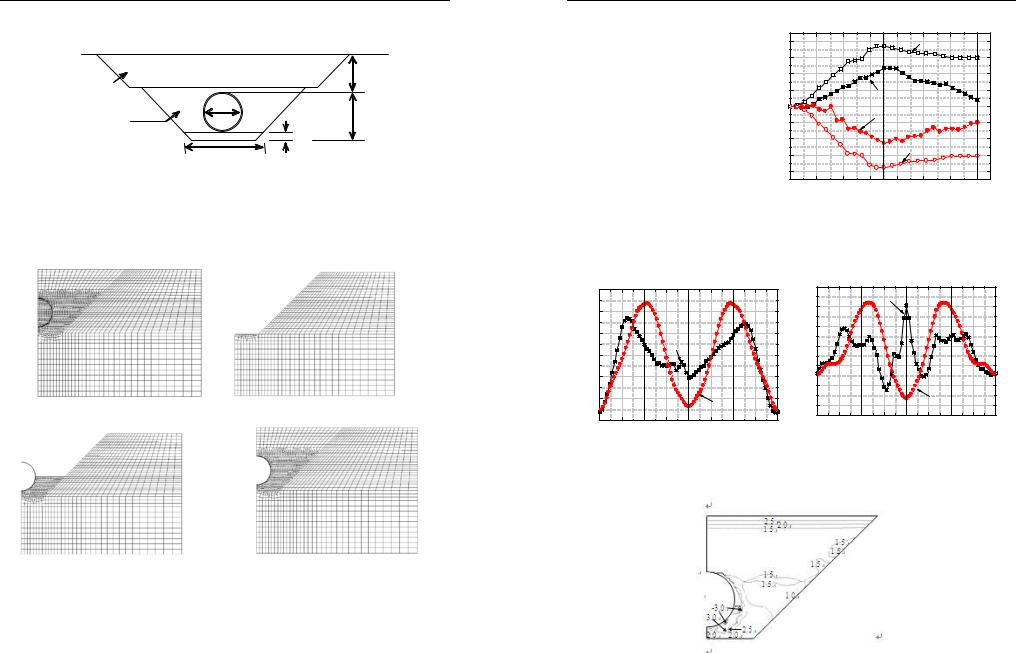
Численные методы расчетов в практической геотехнике
aggregate was accomplished with controlled 30cm layers and compacting the fill to 90 % compaction.
Excavated soil |
|
3500 |
|
|
|
||
1:1.0 |
φ3500 |
|
|
Aggregate RC 40 |
4276 |
||
|
|||
|
|
700 |
7406
unit:mm
Figure 2. Cross section of field experiment
The construction process of buried pipe is shown Figure 3. Initially all elements aresoilsandafterexcavationthepipewassetanddeformedbyselfweight.Thematerial constants of soils and aggregate used for analysis were obtained by triaxial test.
(a) Initial State |
(b) Excavation of soils is completed |
(c) Back-filled to half height of pipe |
(d) Back-filling process is completed |
Figure 3. The construction process of buried pipe
The Figure 4 shows the deflections of the pipe during back-filling process. In this figure, deflection of pipe at the initial stage is set to be zero. The deflections by the analysis show similar to field test result, but the result by analysis is a little bit larger because the assumed initial horizontal stress 20kPa of each layer may be rather large.
286
T. Tanaka, M. Ariyosh, Y. Mohri
The strain distribution of internal surface of the pipe is shown in Figure 5 when the backfilling attained the top level ofthe pipe, The vertical coordinate shows strain (tensionisplus).The horizontal coordinate shows the locationfromthecrownofpipeby angle. Figure 6 shows the strain distribution when the back-filling completed. Figure 7 shows the distribution of stress ratio when the backfilling completed.
|
S et of pipe |
|
B ackfill to top of pipe |
After backfill |
||||
|
20 |
|
|
|
Vertical deflection(FEM) |
|||
|
15 |
|
|
|
|
|
|
|
(mm) |
10 |
|
|
|
|
|
|
|
5 |
|
|
Vertical deflection(Exp.) |
|
|
|||
|
|
|
|
|
||||
Deflection |
0 |
|
|
Horizontal deflection(Exp.) |
|
|||
|
|
|
|
|||||
- 5 |
|
|
|
|
|
|
|
|
- 10 |
|
|
|
|
|
|
|
|
|
|
|
|
Horizontal deflection(FEM) |
||||
|
- 15 |
|
|
|
||||
|
|
|
|
|
|
|
|
|
|
- 20 |
|
|
|
|
|
|
|
|
0 |
1 |
2 |
3 |
4 |
5 |
6 |
7 |
Distance from the bottom of pipe (m)
Figure 4. Deflections of pipe during theback-filling
|
C rown |
|
S pringline |
Invert |
S pringline |
C rown |
C rown |
S pringline |
Invert |
S pringline |
C rown |
|||||||
|
|
150 |
||||||||||||||||
|
150 |
|
|
|
|
|
|
|
|
|
|
|
Exp. |
|
|
|
|
|
strainµ |
|
|
|
|
|
|
|
|
strainµ |
|
|
|
|
|
|
|
|
|
100 |
|
|
|
|
|
|
|
100 |
|
|
|
|
|
|
|
|
||
|
|
|
|
|
|
|
|
|
|
|
|
|
|
|
|
|||
50 |
|
|
|
|
|
|
|
50 |
|
|
|
|
|
|
|
|
||
|
|
|
|
|
|
|
|
|
|
|
|
|
|
|
|
|
||
ircumferentialC |
|
|
|
|
|
|
|
ircumferentialC |
|
|
|
|
|
FEM |
|
|
||
- 100 |
|
|
Exp. |
|
|
|
0 |
|
|
|
|
|
|
|||||
|
|
|
|
|
|
|
|
|
|
|
|
|
|
|
|
|||
|
0 |
|
|
|
|
|
|
|
|
|
|
|
|
|
|
|
|
|
|
|
|
|
|
|
|
|
|
|
- 50 |
|
|
|
|
|
|
|
|
|
- 50 |
|
|
|
|
|
|
|
|
|
|
|
|
|
|
|
|
|
|
|
|
|
|
|
|
|
|
|
- 100 |
|
|
|
|
|
|
|
|
|
|
|
|
|
|
FEM |
|
|
- 150 |
|
|
|
|
|
|
|
|
|
|
- 150 |
|
|
|
|
|
|
|
|
0 |
45 |
90 |
135 |
180 |
225 |
270 |
315 |
360 |
|
0 |
45 |
90 |
135 |
180 |
225 |
270 |
315 |
360 |
|||||||||
|
|
|
Degree from crown (° ) |
|
|
|||||||||||||
|
|
|
Degree from crown(° ) |
|
|
|
|
|
|
|||||||||
|
|
|
|
|
|
|
|
|
|
|
|
|
|
|||||
Figure 5. Circumferential strain distribution |
Figure 6. Circumferential strain distribution |
of pipe (back-filling to top of pipe) |
of pipe (back-filling completed) |
Figure 7. Distribution of ratio of principal stress
287
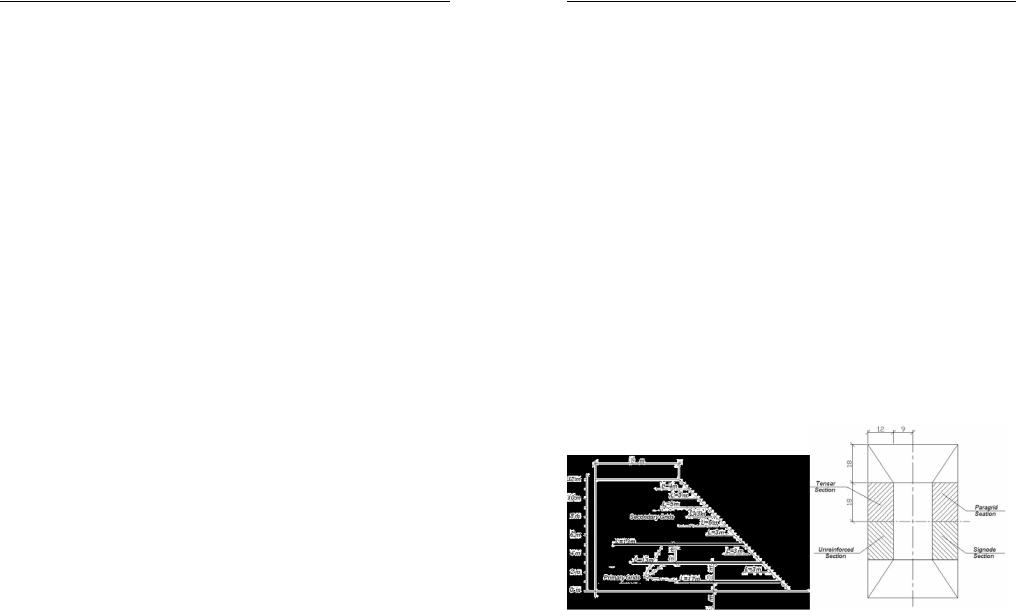
Численные методы расчетов в практической геотехнике
6.CONCLUSIONS
We attempted to solve the deformation, stress and strain of flexible buried pipe bythe elasto-plastic finite element analysis that is taking into acoount the construction process. The conclusions are summarized as follows.
1.Theobserveddeflectionofthepipecanbesimulatedwellbytheelasto-plastic finiteelementanalysis.Alsotheobservedstrainofinternalsurfaceofpipewassimulated reasonably well by the analysis
2.Thecomputedstressbythefiniteelementanalysisshowedcomplexdistribution around the pipe especially the bottom back-fill soils and it is important to follow the
construction process that is taking into account the interaction of soils and structure.
References
1.Okajima,K.,Tanaka,T.andMori,H.(2001),Elasto-plasticfiniteelementcollapseanalysis of retaining wall by excavatio., Computational Mechanics New Frontiers for the New Millennium, Vol.1, 439-444.
2.Siddiquee,M.S.A.,Tanaka,T.,Tatsuoka,F.,Tani,K. andMorimoto,T.(1999), Numerical simulation of bearing capacity characteristics of strip footing on sand, Soils and Foundations, Vol. 39, No. 4, 93-109.
3.Tanaka, T. and Kawamoto, O., (1988), Three dimensional finite element collapse analysis for foundations and slopes using dynamic relaxation, in Proceedings of Numerical Methods in Geomechanics,Insbruch, 1213-1218.
4.Tatsuoka, F., Okahara, M., Tanaka, T., Tani, K., Morimoto, T. and Siddiquee, M. S. A., (1991), Progressive Failure and Particle Size Effect in Bearing Capacity of a Footing on Sand,
Geotechnical Engineering Congress -ASCE, Geotechnical Special Publication 27, Vol. 2, 788-802.
A.Zh.Zhussupbekov, R.E.Lukpanov,A.Tulebekova, I.O.Morev,Y.B.Utepov
(Geotechnical Institute of L.N. Gumilyov Eurasian National University,
Astana, Kazakhstan),
D.Chan (University ofAlberta, Edmonton, Canada)
NUMERICALANALYSISOFLONG-TERM PERFORMANCE EMBANKMENTREINFORCEDBYGEOGRID
Applications of the geosynthetic materials as reinforced elements to strengthen of the embankments slope has a great world practice. The purpose of the numerical analysis was research of the stress-strain conditions of the long-term performance embankmentreinforcedbygeogrid.Thecomparisonofnumericalandmonitoringresults ofhorizontal andverticaldeformationofreinforcedandunreinforcedsection oftested embankmentwaspresentedinpaperaswellasresultsofstressandstraindevelopment, consolidation process of tested embankment after elapse a long term. The obtained
288
A.Zh. Zhussupbekov, R.E.Lukpanov, A.Tulebekova, I.O.Morev,Y.B.Utepov, D.Chan
results of the researching work corroborated the hypotheses that reinforcement is one of the reliable and effective soil improvement models.
1.INTRODUCTION
The concept of earth reinforcement can be traced back to the ancient history. First primitive application of reinforcement was using sticks or branches for the mad dwelling. Modern conception of reinforcement as one of engineering technology has originsincethe1960‘s.Technologyofreinforcementisdevelopedthroughdevelopment of mankind. Nowadays there are a lot of different types ofreinforcement materials are used in a world engineering practice. In spite ofthat people tryto find newtechnology and materialsforreinforcementwhichmightbemoreeffectiveandpracticallyfeasible. Thattheearthreinforcementhasprevalenceontheotherearthimprovementtechnology is undoubted fact, but what will happen with reinforced construction after essential elapsing of time? What the role ofthe reinforcement for the long-termperformance of construction? What the influence for the stress-strain behavior of reinforcement?
Forthatpurposeandfullunderstandingofthelongtermperformanceofreinforced embankment behaviour in 1986 year was constructed artificial embankment by finegrained coherent soil reinforced by geogrid.
2.REINFORCEDEMBANKMENTBACKGROUND
The researching work and design of the reinforced embankment was carried out byengineers ofAlberta University.Testingembankment is 12 mof high,inclinationof 1:1. Embankment consists of four sections, three of them reinforced by different type of geogrid and fourth section non reinforced, see Figure 1.
Figure 1. Tested embankment
ThefoundationsoilwasstudiedbyHofmann(1989). Fourboreholesweredrilled at the test fill site using a wet rotary drill rig which allowed Shelby tube samples, 73
289
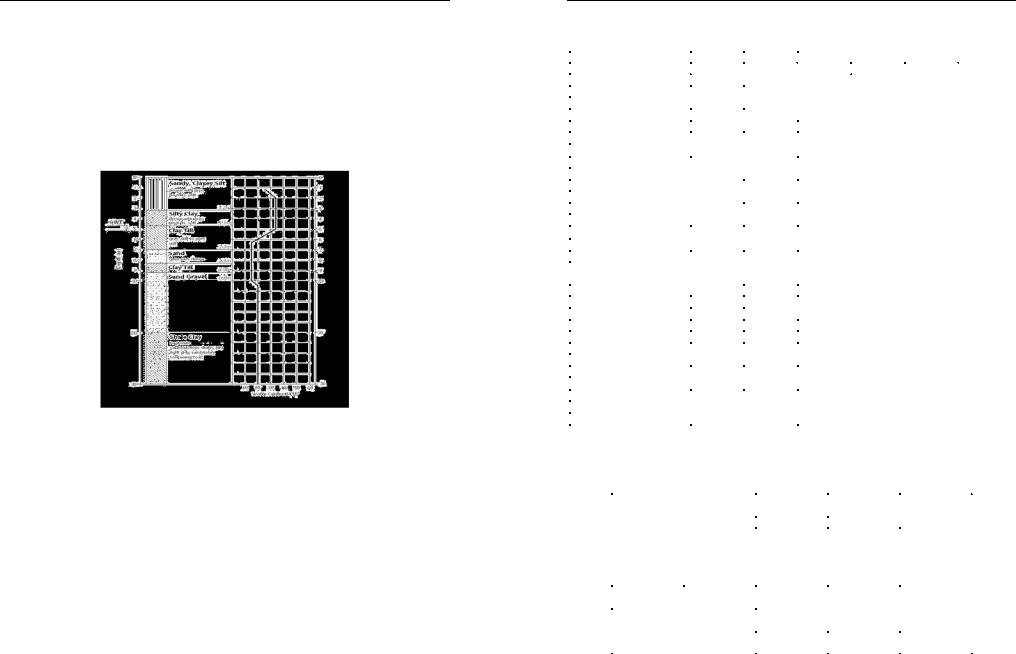
Численные методы расчетов в практической геотехнике
mm in diameter by 610 mm long, to be taken (B.A. Hofmann). The shelby tubes were taken byHofmann about depth of 10 min borehole 1, 3 and 4. In borehole 2, however,
drilling was continued down to clay shale bedrock at 27 m, without sampling. Examination of the material removed as drilling progressed showed that the
grey sand was continuous to the bedrock. Alberta Transportation and Utilities drilled and logger a total of 70 boreholes at various locations along the new alignment of Highway 60 to the depth at 20 m. Atypical borehole profile is shown in Figure 2 and results of laboratory tests of the foundation and filling soils obtained by Hofmann and Alberta Transportation is shown in Table 1. The groundwater table is 5 m below the ground surface (Barbara, A. Hofman, 1989).
Figure 2. Profile of foundation soil
For the reinforcing of the test embankment it was chosen to use three types of hightensilestrengthgeogrids:TensarSR2,SignodeTNX5001 andParagrid50S.Their physical properties provided by the manufacturers are summarized in Table 2 (Y. Liu). Beforethegeogridswereused inthetestfill,load-extentionprorertiesofreinforcement materials were obtained from unconfined tests such as the grab tensile test, the steip tensile test and wide width tensile test.
Therewere defectsin theParagrid material supplied and placed inthe test fill. It was found during laboratory tests that some of the high strength fibers in the tension members were weakened or damaged at the intersections of the grids. This damage was most likely caused byoverheatingof the polypropylene sheathduring the welding process.DuringtestofSignodesectionitwasfoundthatmostinstrumentationdamaged and not good for interpretation of the instrumentations results, therefore it was chosen to use Tensar section for the FEM analysis by Plaxis (Y. Liu, 1992).
A.Zh. Zhussupbekov, R.E.Lukpanov, A.Tulebekova, I.O.Morev,Y.B.Utepov, D.Chan
Table 1
Properties of upper foundation soil and filling soil
Properties of soil |
Index |
|
Value |
|
Unit |
Index |
Value |
Unit |
|
|
|
|
Foundation soil |
|
|
Fill soil |
|
||
|
|
|
Atterberg Limits Tests |
|
|
|
|
||
Water contents |
Wn |
|
36,4 |
|
% |
Wn |
20 |
- 23 |
% |
Liquid Limit |
Ll |
|
46,7 |
|
% |
Ll |
37.4 |
% |
|
Plastic Limit |
Lp |
|
21,5 |
|
% |
Lp |
20.9 |
% |
|
Plasticity Index |
IP |
|
25,2 |
|
% |
IP |
16.5 |
% |
|
Dry Unit Weight |
γdry |
|
18 |
|
kN/m3 |
γdry |
17 |
|
kN/m3 |
Saturated Unit Weight |
γ |
|
20 |
|
kN/m3 |
γ |
20 |
|
kN/m3 |
|
sat |
|
|
|
|
sat |
|
|
|
|
|
Grain Size Distribution Tests |
|
|
|
|
|||
Sand |
- |
|
5 |
|
% |
- |
20 |
|
% |
Clay |
- |
|
20 |
|
% |
- |
18 |
|
% |
Silt |
- |
|
75 |
|
% |
- |
62 |
|
% |
|
Consolidation Tests (Stress Range 800kPa, Pc` - 458 kPa) |
|
|
|
|||||
Coefficient of Consolidation |
Cv |
|
0,001 |
|
cm/s |
Cv |
54 |
- 73E-4 |
cm/s |
Compression Index |
Cc |
|
0,535 |
|
- |
- |
- |
|
- |
Recompression Index |
Cr |
|
0,053 |
|
- |
- |
- |
|
- |
Time factor |
t90 |
|
2.43 |
|
min |
t90 |
23 |
- 39 |
min |
Coefficient of Volume |
Mv |
|
1.41E-4 |
|
m/кН |
- |
- |
|
- |
Compressibility |
|
|
|
|
|
|
|
|
|
Coefficient of Permeability |
k |
|
1.03E-7 |
|
cm/s |
|
|
|
|
|
|
Triaxial and Direct Shear Tests |
|
|
|
|
|||
Sell Pressure |
σ1 |
|
518 |
|
kPa |
σ1 |
80 |
- 240 |
kPa |
Density |
ρd |
|
1.859 |
|
g/cm |
ρd |
1.7 - 1.72 |
g/cm |
|
Void Ratio |
e |
|
1.894 |
|
- |
e |
0.59 - 0.62 |
- |
|
Degree of Saturation |
Sr |
|
84.0 |
|
% |
Sr |
91 |
– 96 |
% |
(σ1 – σ3) |
(σ1 – σ3) |
|
427 |
|
kPa |
(σ1 – σ3) |
129-274 |
kPa |
|
Strain |
ε |
|
8.1 |
|
% |
ε |
15.0 |
% |
|
Friction Angle |
φ |
|
24 |
|
° |
φ |
28 |
|
° |
Cohesion |
c |
|
23 |
|
kN/m2 |
c |
20 |
|
kN/m2 |
Elastic Modulus |
E |
|
35000 |
|
kN/m2 |
E |
28000 |
kN/m2 |
|
Poison`s Ratio |
ν |
|
0,4 |
|
- |
ν |
2.3 – 4.5 |
- |
|
|
|
|
|
|
Table 2 |
|
|
|
Physical propertiesof geogrids |
|
|
||
|
|
|
|
|
|
|
Type of material |
Tensar |
Signode |
Paragrid |
|||
|
|
|
|
|
|
|
Type of polymer |
Polyethylene |
Polyester |
Polyester |
|
||
Structure |
|
Uniaxial greed |
Rectangular |
Quadrangle |
|
|
Junction Type |
Planar |
Welded |
Welded |
|
||
Weight, (g/m) |
930 |
544 |
530 |
|
||
Open Area, (%) |
55 |
58 |
78 |
|
||
Aperture size |
|
MD |
99.1 |
89.7 |
66.2 |
|
(mm) |
|
CMD |
15.2 |
26.2 |
66.2 |
|
Thickness (mm) |
T 1.27 |
T 0.75 |
T 2.05 |
|
||
A 4.57 |
J 1.50 |
J 3.75 |
|
|||
|
|
|
|
|||
Color |
|
Black |
Black |
Yellow |
|
|
Tensile Force |
19 - 20 |
32 – 34 |
--- |
|
||
(2% strain), kN/m |
|
|||||
|
|
|
|
|||
290 |
291 |
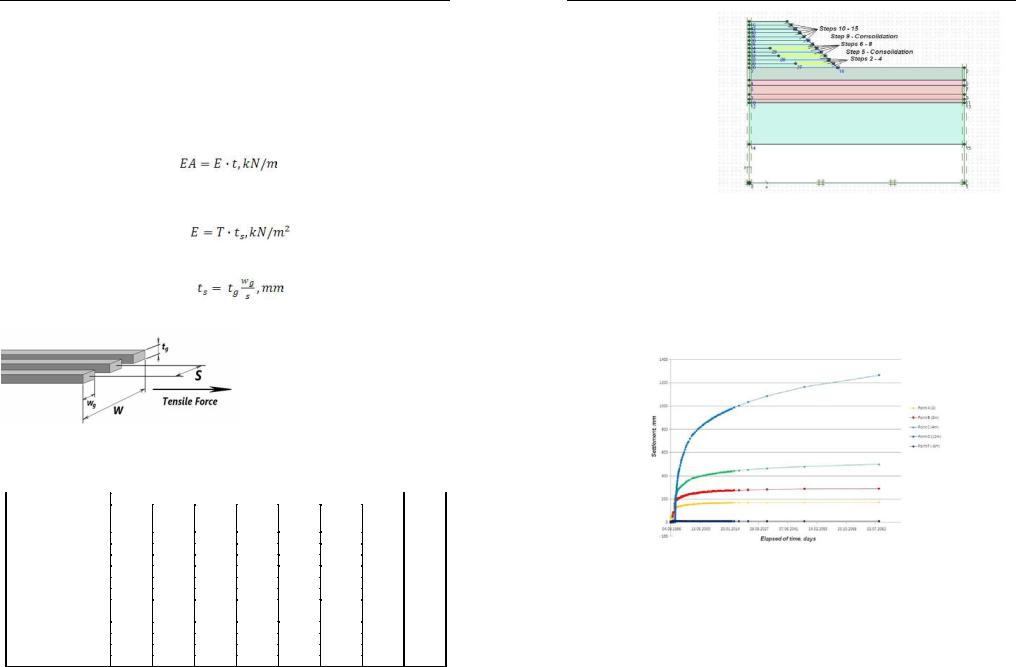
Численные методы расчетов в практической геотехнике
3.2D SIMULATION OFREINFORCED EMBANKMENTBYPLAXIS
Properconstructivmodelsof the testfilland material parametersshould be used inthefiniteelementanalysis.Nonlinearstress-strainrelationshipwereusedformodeling the behavior of the soil, and the model parameters were derived based on labaratory test results. The load-strain behavoiur of geosynthetic under test conditions of 200C and rate 2% per minute were used to model the reinforcement (Chang-Tok Yi, 1995).
For analysis of reinforced embankment by Plaxis we need to know only one perameterofgeogridisanelasticnormal(axial)stiffenessofgrids,whichcanbedefined:
(1)
where EA is elastic normal (axial) stiffeness of grids, kN/m; E is Young‘s modulus of the geotextile, kN/m2; t is thickness of the fabric, m.
Young‘s modulus of the geotextile is obtained from having tensile force:
(2)
where T is tensile force, kN/m; ts is trasformed thickness of geogrid, mm. Transformed thickness of the gegrid defined by next equation:
|
|
|
|
|
|
|
|
(3) |
||
|
|
|
|
where |
tg is ribs thickness of geogrid, |
|||||
|
|
|
|
mm; wg isribs widthof geogrid, mm; s |
||||||
|
|
|
|
is space between rigs of geogrid |
||||||
|
|
|
|
(Figure 3), mm. |
|
|
|
|
||
|
|
|
|
|
Propertiesofthefoundationsoil, |
|||||
|
|
|
|
fill soil and reinforcements accepted |
||||||
|
|
|
|
for FEM analisys by Plaxis are shown |
||||||
|
|
|
|
onTable 3. |
|
|
|
|
|
|
Figure 3. Geometrical Parameters of Geogrids |
|
|
|
|
|
|
|
|||
|
|
Parametersof materials |
|
|
|
Table 3 |
||||
|
|
|
|
|
|
|
|
|||
|
|
|
|
|
|
|
|
|
|
|
|
|
|
|
Foundation Soil |
|
|
|
|
|
|
Parameters |
Sandy Clayey Silt |
Silty Clay |
Clay Till |
Sand |
Clay |
Sand & Gravel |
Clay Shale |
Soil |
||
|
|
|
|
|
|
|
|
Fill |
||
Material Model |
M-C |
M-C |
M-C |
M-C |
M-C |
M-C |
M-C |
M-C |
|
|
Behaviour |
Drain |
Drain |
Drain |
Drain |
Drain |
Drain |
Drain |
Drain |
|
|
Dry Soil Weight, kN/m3 |
18 |
18 |
17 |
15 |
19 |
18 |
19 |
17 |
|
|
Wet Soil Weight, kN/m3 |
20 |
20 |
19 |
20 |
21 |
22 |
21 |
20 |
|
|
Hor. perm., m/day |
1.3E-7 |
1E-7 |
1E-7 |
1E-4 |
1E-8 |
1E-2 |
1E-9 |
1E-7 |
|
|
Vert. perm., m/day |
1.3E-7 |
1E-7 |
1E-7 |
1E-4 |
1E-8 |
1E-2 |
1E-9 |
1E-7 |
|
|
Elastic Modulus, kPa |
35000 |
24000 |
90000 |
1,2 |
26000 |
24 |
42000 |
28000 |
|
|
|
|
|
|
Е+5 |
|
E+4 |
|
|
|
|
Possion`s Ratio, - |
0.4 |
0,4 |
0.42 |
0.38 |
0.4 |
0.35 |
0.4 |
0.35 |
|
|
Cohesion, kPa |
23 |
25 |
30 |
1 |
35 |
0,1 |
48 |
20 |
|
|
Friction ang., 0 |
24 |
24 |
25 |
35 |
25 |
40 |
21 |
28 |
|
|
Dilatancy angle, 0 |
24 |
24 |
25 |
35 |
25 |
40 |
21 |
28 |
|
|
Magnitude of normal stiffness of Tensar SR2, EA= 51kN/m.
A.Zh. Zhussupbekov, R.E.Lukpanov, A.Tulebekova, I.O.Morev,Y.B.Utepov, D.Chan
Full assignment |
|
consist of 33 steps, firs of |
|
all we need to know initial |
|
condition of embankment, |
|
next steps are compactions |
|
of intermediate soils stra- |
|
tum and reinforcement |
|
layers instalations, that is |
|
lead to increase pore |
|
pressure of ground water, |
|
and decreaseofthe φ andc |
|
parameters. The steps of |
Figure 4. Steps of the embankment erection |
embankment erection are |
|
shown on Figure 4. |
|
It was chosen several interested us points for the analysis of embankment settlement. Taken points are corresponds to positions of instrumentations.
According results full settlement due to of full consolidation will be in 2602 year, but forpoint D (12 m) the settlement will be neglected small at 2055, with rate of 0.5 mm per year. For pointA(0 m) same rate of settlement occur after 2001, for point B (2m) – 2012, point C (4 m) – 2025, point F (-6 m) after two years. Predictable settlement curve is shown on Figure 5.
Figure 5. Predictable settlement curve
The settlement of unreinforced section almost has the same value as reinforced section.As in-situ test results shown the magnitude of point D settlement (12 m high) is 820 mm for unreinforced section whereas reinforced section settlement is 750 mm. For the curiously Plaxis results has the same picture. Unreinforced and reinforced section settlements obtained by in-situ observation and Plaxis simulations are shown on Figure 6 and 7 (Chan, D., Lukpanov, R., 2008).
292 |
293 |
